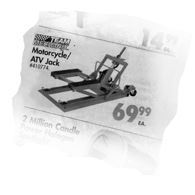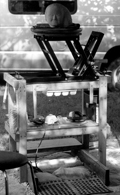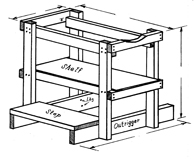It was a bright sunny day; the air was warm but not uncomfortable. There seemed to be little chance for rain to dampen my enjoyment of my first Stone Carvers’ Symposium at Camp B. Feeling in good spirits, I had just finished setting up my work bench when suddenly I looked up and was shocked to see a rabble of 30 or 40 persons bearing down on me. This unruly mob appeared to be led by a wild-looking woman riding a strange motorized vehicle! As they drew nearer I became aware that many of them were carrying rocks and various other threatening objects. Then, as I cowered further back under my shade canopy, they charged in, pelting me and my work bench with the rocks and dust and such while ranting all manner of strange incantations! But, I get ahead of myself.
I had been carving in clay for some years when I heard of the Symposium and decided it was time to try a new medium. Unfortunately, I knew only two things about sculpting in rock: 1) Rock is hard, and 2) Rock is heavy.
I couldn’t do much about the first, but I assumed I should be prepared for the second. So, I set out to construct a work stand.
It is easy to build a sturdy, fixed stand, but I also knew that one often needs to change one’s perspective (angle of attack) and that the simple, center-pole apparatus used with the light clay pieces wouldn’t work with a heavy stone. Hmmm, what to do?
The answer magically appeared in the Sunday ads: Schuck’s Auto Store was selling an ATV jack for $69.99. The thing could lift 1200 pounds a full twelve inches. (I have seen Michelangelo’s David and, although I suspect that it is heavier than 1200 lbs, I didn’t think I’d be working on a piece that big. Well, not at first.) So, off to the store I went.
Once I got the jack home I realized there was one small problem; it was designed to sit on the garage floor. I am not. So, I needed to lift the lifter. A trip to Lowe’s and a few saw cuts got me the necessary ingredients which I list at right with a drawing of the lifter table.
First, I removed the wheels from the jack, no need for those things. But then the basic question was: how high? I initially made the legs 36” long, giving me enough height to occasionally sit on a stool and work. I also knew I could easily shorten them later if necessary.
Next I built a frame for the jack to sit down into. The inside of the frame is just a scant 1/8” longer and wider than the jack’s footprint, so I could lift the jack out if need be. (I had to cut down the rear cross piece a bit to allow for a lifting handle on the jack.) The long side supports are dropped down 1-1/4” below the top of the legs and end supports to keep the jack in place.
I added four more support pieces half way down to give the legs stability and to hold up a half-inch plywood utility shelf.

Finally, I added 2” x 6” outriggers to give the stand stability in its narrow axis. I attached the outriggers to the legs with lag screws for easy removal. I also cut a 2” x 12” step to set across the outriggers giving me seven more inches of attitude adjustment. (19” total.) I cut the step so it barely fits between the vertical legs. This tends to keep it in place but allows me to slide it to the other side or tuck it under the bench as needed.
The jack’s lifting surface is made up of two rubber-covered feet with a lug at the toe and heel to keep your ATV from sliding off. This arrangement makes a rough 12” x 12” platform but it really isn’t suitable to hold a stone, so I cut a 21” x 21” work-top from 3/4” plywood. I needed half-inch deep groves in the bottom of the plywood to fit over the lugs so the top would sit flat on the jack’s feet. The lugs keep the top from shifting. Finally, I screwed ‘L’-shaped pieces of angle-iron along the perimeter of the work-top to keep my piece from sliding off.
I built a second, Lazy Susan work-top using a TV-rotator set between a pre-cut 18” round table top I found at Lowe’s and another plywood base. (The base is the same diameter as the table-top and also has the lug groves to keep it in place.) I arrest the Lazy Susan’s rotation by dropping a carriage bolt down through a hole drilled in the top into one of several holes drilled along the perimeter of the base piece.
The three-foot long pump handle that comes with the jack was just too ungainly, so I drilled a hole in a wooden hammer handle to fit over the pump stud instead.
For transportation the whole thing can be broken down into easily managed parts by unscrewing the outriggers and lifting the jack out of the stand.
There are several bells and whistles you might want to add: a small grinder on the utility shelf, a drawer for chisels, pegs for hammers, a power bar for electrical tools, a swivel light, a drink-of-choice holder, etc.
Now, where is that pesky rock?
The author makes the following disclaimer. Caution! If you build one of these things, do not casually mention to Verna Dee Dice that you would like for her to ‘bless’ it or else you may suddenly look across the field at Camp B and see a gaggle of people advancing upon you with rocks and stones and dust and flower petals in their hands.
Stuart is retired and lives in Warm Beach, WA with his wife and two young daughters. He would be glad to answer any questions on this project. Phone: (360) 652-1897 or e-mail: This email address is being protected from spambots. You need JavaScript enabled to view it..
Specifications

Lumber
4 - 2” x 3” x 36” for legs
4 - 2” x3” x 31 - 1/4” for side supports
4 - 2” x3” x 19” for end supports
2 - 2” x 6” x 37” for outriggers
1 - 2” x 12” x 26” for step
1 - 13” x 34 - 1/4” 1/2” plywood for utility shelf
1 - 21” x 21” - 3/4” plywood for work top
1 - 18” rd. - 3/4” plywood for Lazy Susan base
1 - 18” rd. end table top (pre-cut, ready-to-finish)
Hardware
36 - #10 wood screws 3” long
8 - 3/8” lag screws 3” long
1 heavy duty Lazy Susan turn-table
4 - L shaped pieces of angle iron 12” long for stops
1 wooden replacement handle for a hammer
1 - 3/8” carriage bolt 2-1/2” long for Lazy-Susan stop
Note: I used the unusual 2” x 3” sized lumber because 2” x 2” seemed too weak and the more traditional 2” x 4” seemed too clunky. The dimensions in this drawing reflect the actual finished size of 1.5” x 2.5”.

